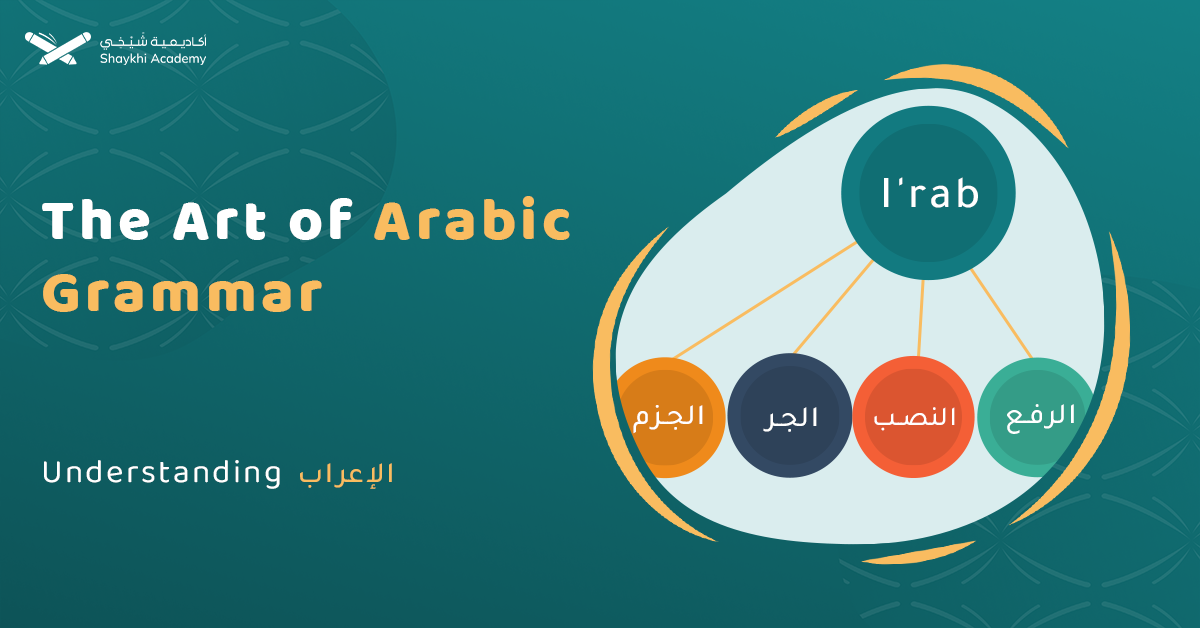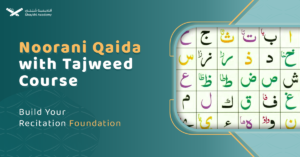One of the most important features of the Arabic grammar system is the Arabic cases. They may be challenging at first but with practice, they adore them since they help you understand the sentence deeply. Changing a word’s grammatical case can give the sentence a different meaning.
In this topic, we will learn about all Arabic cases, their different types, and how they can change the meaning of a sentence.
Arabic Cases الإعراب
The Arabic Cases refer to the word’s grammatical cases. These cases determine the endings of nouns, and verbs and are marked with specific diacritics or vowels. The Arabic cases are called in Arabic “ إعراب” which means changing the diacritics of the last letter of the word according to its grammatical role.
A grammatical position in the sentence does not necessarily mean having the Mark of the Arabic case. Some words are “Mabniya,” meaning they have fixed endings that are not affected by their grammatical position. The following image explains this.

Arabic cases usually disappear in different dialects to facilitate the sentence, and the meaning will be understood from the context. If you want to get deep into a definite dialect, we provide special courses for dialects, such as Levantine Arabic classes.
How Many Cases Are in Arabic Grammar?
Arabic grammar features three primary grammatical cases for nouns—nominative, accusative, and genitive—and three for present-tense verbs—nominative, accusative, and jussive. Nouns, distinguished by their flexibility (معربة), shift endings depending on their role in sentences, while particles remain fixed (مبنية).
Nouns take the nominative case when acting as subjects, predicates, or doers of actions, marked by a damma (e.g., “السماءُ صافيةٌ” – “The sky is clear”).
In contrast, the accusative case, indicated by a fatha, denotes objects or adverbs, such as in “رأيتُ قمرًا” (“I saw a moon”).
The genitive case, seen after prepositions or in possessive constructs, uses a kasra, as in “في الفصل” (“In the classroom”).
Verbs, predominantly fixed (mabniya), vary only in the present tense (mu‘rab). Present-tense verbs adopt nominative (damma), accusative (fatha), or jussive (sukoon) forms, depending on preceding particles.
For instance, “يكتب” (“He writes”) is nominative, “لن يكتب” (“He will not write”) is accusative, and “لم يكتب” (“He did not write”) is jussive. Mastery of these cases demands practice, and structured group classes can offer collaborative learning to deepen understanding.
Here is a detailed information about nominal and verbal grammatical cases:
1. Arabic Cases of Nouns
The Noun is a word that indicates a meaning by itself and is not associated with any of the three tenses (past, present, or imperative). Most nouns change their ending according to the grammatical positions or “maraba” معربة with few exceptions. Nouns can have 3 cases:
a. Nominative Case:
The nominative case can be used for both Nouns and Verbs. The main mark for this case is the Damma “الضمة”. Nouns come in the nominative case when they have the following Grammatical cases:
| Grammatical Term | Arabic Sentence | Transliteration | Translation |
| مبتدأ (Subject) | السماءُ صافيةٌ. | al-samā’u ṣāfiyatun | The sky is clear. |
| خبر (Predicate) | الماءُ عذبٌ. | al-mā’u ʿadhbun | The water is fresh. |
| فاعل (Doer of Action) | كتبَ الطالبُ الدرسَ. | kataba al-ṭālibu al-darsa | The student wrote the lesson. |
| خبر إنّ (Predicate of Inna) | إنّ الحديقةَ جميلةٌ. | inna al-ḥadīqata jamīlatun | Indeed, the garden is beautiful. |
| اسم كان (Subject of Kana) | كانَ الرجلُ قوياً. | kāna al-rajulu qawiyyan | The man was strong. |
b. Accusative Case:
The accusative case can be used for both nouns and verbs as well. The main mark for this case is the Fatha “الفتحة” but changes in special cases. There are many Arabic adverbs. The following table explains common types:
| grammatical term | example | Transliteration | translation |
| مفعول به (Direct Object) | رأيتُ قمرًا. | ra’aytu qamaran | I saw a moon. |
| ظرف زمان (Adverb of Time) | ذهبتُ صباحًا. | dhahabtu ṣabāḥan | I went in the morning. |
| حال (Adverb of Manner) | ذهبتُ مسرعًا. | dhahabtu musri‘an | I went quickly. |
| مفعول لأجله | ذهب طلبًا للعلم | dhahabtu talabn llailm | I went seeking knowledge |
| حال (State/Adverbial Clause) | تحدثتُ مبتسمًا. | taḥaddathtu mubtasiman | I spoke while smiling. |
There are other cases for the noun accusative cases such as the following examples:
| The grammatical case | example | translation | transliteration |
| اسم كان (Kaana’s Subject) | وكان الله غفورًا رحيمًا. | wa kāna Allāhu ghafūran raḥīman | And Allah has always been Forgiving and Merciful. |
| خبر إن (Inna’s Predicate) | إنَّ اللهَ كريمٌ. | inna Allāha karīmun | Indeed, Allah is Generous |
c. Genitive Case:
This case occurs only for nouns. From this you can understand why you can distinguish the nouns in the Arabic language through the following 3 criteria:
- Ability to add ال definite- article.
- Ability to have Tanween.
- Ability to come in a Genitive case.
There are 2 main genitive cases explained in the following table:
| The grammatical case | How to know | example | translation | transliteration |
| اسم مجرور | After a preposition | في الفصل | In the classroom | fī al-faṣli |
| مضاف إليه | Usually a definite noun after an indefinite noun. | شباك الفصل | The window of the classroom. | shubbāku al-faṣli |
2. Arabic Cases of Verbs
The verb is a word that is related to a time and events. “Unlike nouns, Arabic verbs are primarily mabniya (in fixed forms) with fixed endings. The past and imperative tenses are Mabnyia but the present tense is Mu’arb. The verb in present tense has 3 variable cases explained in the following table.
| Case | the main mark | Usage |
| Nominative | damma | the primary case of present verbs. |
| Accusative | fatha | when present verbs are preceded by accusative particles such as ” أن -لن- كي -حتى -لام التعليل” |
| Jussive | skoon | When present verbs are preceded by jussive particles such as conditional particles that affect 2 verbs or preceded by negative commands لم لم particles.ا |
Let’s make this clear by examples in the following table
| example | transliteration | translation |
| يكتب | yaktubu | He writes. |
| لم يكتب | lam yaktub | He did not write. |
| لن يكتب | lan yaktuba | He will not write. |
| يسمع | yasma‘u | He hears. |
| لن يسمع | lan yasma‘a | He will not hear. |
| لم يسمع | lam yasma‘ | He did not hear |
You can extract more examples and practice more in groups with our Arabic Group Classes.
What Are the Special Cases in Arabic?
You can understand now that the Arabic cases are 4 main types. Each type has special grammatical cases. Both nouns and verbs can be in nominative and accusative cases. The Gentive case is special for nouns and the jussive case is special for verbs. See the following chart to understand this.
Read more about: The 9 Arabic Interrogatives With Examples And Exercises
Arabic Cases Examples
You need to practice distinguishing these different Arabic cases from each other. This can help you realize their importance and how they can change the meaning. Before this, you should learn the marks of Arabic cases. Each Arabic has an Original mark (أصلية) and alternative marks (فرعية) that are used in special cases. Here is a breakdown for All Arabic cases.

1. Nominative
The main mark for the nominative case is the Damma ( ُ ). This means that when the grammatical case of the word is nominative, you will use this diacritic, the Damma, on the last letter of the word except in the cases explained in the following table.
| Case | the alternative mark | example | translation | transliteration |
| Dual | the letter Alif “ا” | الطالبان مجتهدان | the 2 students are diligent | al-ṭālibān mujtahidān |
| The Five Nouns | the letter waw “و” | أباك | Your father | About |
| The Five Verbs | The letter noun “ن” retention | يلعبون ويسبحون | they are playing and swimming | yalaʿabūn wa yusabbihūn |
| The regular plural masculine | The letter waw “و” | العاملون مسلمون | the workers are Muslims | al-ʿāmilūn muslīmūn |
2. Accusative
The original mark for the accusative case is the Fatha ( َ ). For this reason, you will find the Fatha on the last letter of the word except the cases explained in the following table.
| Case: | the alternative mark | example | translation | transliteration |
| Dual | the letter yaa ( ي) | رأيت الطالبين | I saw the 2 students. | Ra’aytu al-ṭālibayni |
| The masculine regular plural. | The letter yaa (ي) | رأيت العاملون | I saw the workers | Ra’aytu al-ʿāmilūn |
| The Five Verbs. | Omission of The letter noun “ن”. | لن يلعبوا | They would not play | Lan yalʿabū |
| The Five Nouns | The letter alif “ا” | رأيت أخاك | I saw your brother | Ra’aytu akhāka |
| The regular feminine plural | The Kassra ( ِ ) | رأيت الطالبات | I saw the female students | Ra’aytu al-ṭālibāt |
3. Genitive:
This case is used for Nouns only. The original mark for this case is the Kassra ( ِ ). There is only one Alternative mark that is used for 3 cases: the dual, masculine regular plural, and the Five nouns.
4. Jussive:
The original mark for Jussive is the skoon. This case is special for verbs. There are only 2 cases where the skoon is not used.
1. If the verb was Ajwaf which means “contain vowel letter in middle” or Naqis which means “last letter is the vowel”, the vowel letter will be removed. See the first example of the table.
2. If the verb was one of the Five Verbs. The letter noun will be removed similar to the accusative. See the second example in the table.
| verb | Example | Translation | Transliteration |
| يقول | لم يقل | He did not say | lm yakol |
| يلعبون | لم يلعبوا | they did not play | lm ylaabo |
Now we can explore the following examples to practice this solid information. You can see that one diacritic can change the meaning totally.
| Arabic Example | Transliteration | Translation | Arabic Marking |
| الطلّابُ يذهبون إلى المدرسة. | al-ṭullābu yadhhabūn ilā al-madrasa. | The students are going to the school. | الطلابُ damma يذهبون noun letter retention |
| الفتاتان يرسمان الرسمتين. | al-fatātān yarsimān ar-rasmatayn. | The two girls are drawing the two pictures. | الفتاتان alif nominative dualالرسمتين yaa accusative dual |
| أخوك خلوقٌ. | akhūka khulūq. | Your brother is well-mannered. | Waw letterأخوك “one of the Five nouns”خلوق damma nominative |
| اعتنِ بأبيكَ جيّدًا. | iʿtanī bi-abīka jayyidān. | Take good care of your father. | بأبيك yaa as “five nounsجيدًأ fatha accausative |
| المدرّسون يبذلون كلّ جهدهم في إعطاء المادة العلميّة. | al-mudarresūn yabdhilūn kullu juhdihim fī iʿṭā’ al-mādah al-ʿilmīyah. | The teachers are putting all their effort into teaching the academic subject. | المدرّسونُ (waw, nominative plural), كلَّ (Fatha, accusative), جهدَهُمْ (Fatha, accusative), المادةَ (Kassra,gentive) |
| اختبر الطالبُ المعلمَ | ikhtabara al-ṭālibu al-muʿallima | The student tested the teacher. | الطالبُ (Damma, nominative – subject), المعلمَ (Fatha, accusative – object) |
| احتبر الطالبَ المعلمُ | iḥtabara al-ṭāliba al-muʿallimu | The teacher tested the student. | الطالبَ (Fatha, accusative – object), المعلمُ (Damma, nominative – subject) |
The two last sentences consist of the same words but with different diacritics. This causes a great difference in the meaning. You can explore many sentences and master Arabic in a very short time in our intensive Arabic course.
Arabic Case-ending exercises
This is the time to examine your understanding: try to distinguish the Arabic case words in the following sentence sentences and extract the original and the alternative marking.
- الطائرُ يغني جميلًا.
- محمدٌ كتب رسالتين.
- الفتاةُ ترسم زهرة.
- المعلمُ شرح الدرس.
- الشمسُ تشرقُ الآن.
- الولدُ يقرأ كتابًا.
- الأمُّ تطبخ الغداء.
- الطفلان يلعبان كرة.
- القطةُ تأكل طعامًا.
- العاملات توقفن فجأة.
Practice More Arabic Cases With Shaykhyi Academy Online:
Learning Arabic Cases is very easy with practice. Classical Arabic course in Shaykhyi Academy provide many exercises in Arabic Cases endings and all Arabic grammar. Our teachers are natives and this will help you comprehend the rules and speak while applying them without any mistakes.
One of the prominent advantages of shaykhyi Academy is that our teachers can guide you and simplify all grammar for you whatever your previous background. Do not waste the time and sign up for a free trial with our courses here.
Why Shaykhi Academy?
- Expert Native Tutors: Learn from highly qualified native Arabic speakers.
- Flexible Scheduling: Tailor your classes to fit your busy life.
- Affordable Learning: Access top-quality education at a price that suits you.
- Global Access: Study from anywhere in the world.
Explore Our Arabic Courses:
- Noorani Qaida: Build a strong foundation in Quranic Arabic.
- Comprehensive Arabic Courses: Master the Arabic language, from beginner to advanced levels.
- Fusha Arabic Classes: Delve into Modern Standard Arabic, the key to understanding literature, media, and formal communication across the Arab world.
- Quranic Arabic Course: Enhance your connection with the Quran by learning the language in which it was revealed.
Start Your Arabic Journey Today! Whether you’re just starting or looking to deepen your knowledge, Shaykhi Academy is here to support your journey. Book your free trial now and begin your path to Arabic mastery!

Conclusion
Arabic cases are divided into four main categories: الرفع (nominative), النصب (accusative), الجر (genitive), and الجزم (jussive). You know the case of the word by understanding its grammatical role. Each case in the Arabic case systems has an original diacritic mark. When you master this system and know the marking system used you can gain a better understanding of the Arabic language and see another part of the Arabic language’s beauty.

















































